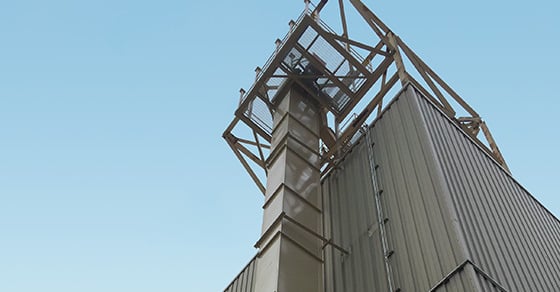When it comes to vertically conveying bulk solids, the bucket elevator is unmatched in its capabilities. This diverse, high-capacity machine has become an essential tool at plants handling everything from fertilizers and minerals, to specialty chemicals and aggregates.
The criticality of the bucket elevator is such that when it comes time to replace it, special considerations and precautions must be taken in order to minimize downtime and ensure the best elevating solution is reached.
When it’s Time to Consider Bucket Elevator Replacement
There are many situations in which a producer should consider replacing their existing bucket elevator(s):
Inefficient Performance
An inferior or inefficient elevator can cause a number of issues that all take away from the bottom line:
- Reduced plant capacity
- Excessive downtime
- Increased maintenance costs and repairs
- Inflated energy costs
- Wasted product
As a result, replacing an underperforming bucket elevator can often quickly pay for itself in avoided costs.
A wide variety of issues may cause a bucket elevator to operate poorly or below its rated capacity. This might include such things as worn or deformed buckets, slippage of belt on pulleys, improper filing of buckets, and more.
Additionally, many bucket elevators perform inadequately because of their design. Not all elevators are created equal and some designs simply outperform others. Further, the diverse handling characteristics of different materials demand a customized handling solution in most cases. Elevators designed based on a one-size-fits-all approach are often riddled with problems and increased downtime because they were not designed to work with the specific requirements of the material being handled.
Process or Material Conditions Have Changed
Similarly, problems can also result if a significant change in feedstock occurs. Well-designed elevators can quickly become problematic when feedstock parameters change. Some adjustments, like changing belt/chain speed, or switching bucket style or spacing, may be able to resolve the issues, but in some cases, replacement may be necessary, depending on the level of change encountered. In any case, when a change in feedstock occurs, bucket elevator design should be reassessed to ensure optimal performance.
Additional Capacity Needed
Unless planned for at the time of construction, plants requiring additional capacity usually have to replace their bucket elevator to accommodate the added load. Bucket elevators are available in a wide range of capacities for use in nearly any setting, making the upgrading process fairly straightforward. Elevators may also be over-designed for anticipated operational growth in the future.
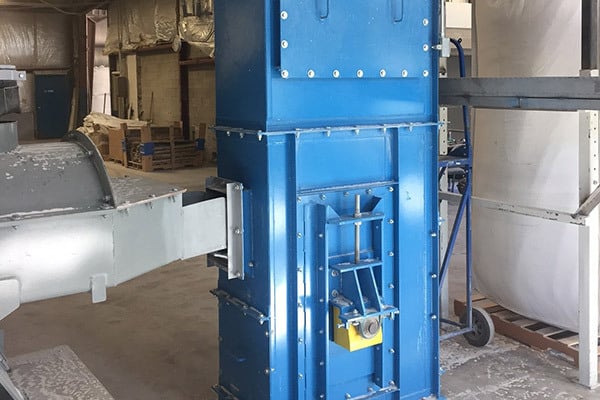
Boot section of replaced bucket elevator
Worn or Damaged
A worn or damaged bucket elevator is one of the most common reasons for replacement. Damage may be due to a corrosive material, inadequate or improper maintenance, old age, or a number of other factors.
If at any point a bucket elevator becomes a safety hazard or the structural integrity of the casing has been compromised, and the issue cannot be resolved through repairs, the elevator must be replaced.
Important Considerations in Replacing a Bucket Elevator
Be Preemptive
As an arterial component of most operations, an out-of-commission bucket elevator can hold an entire operation hostage. To avoid a catastrophic failure during the production schedule, bucket elevators should be preemptively replaced before they have a chance to break down unexpectedly.
Since bucket elevators are a very custom component, replacement can take up to a few months. Preventative replacement will minimize the amount of downtime required for replacement and also avoid the problems associated with an unanticipated outage.
Evaluate the Existing Elevator’s Design
The replacement of a bucket elevator provides a valuable opportunity to improve on any shortcomings of the prior unit(s). Consider questions such as:
- Is the existing elevator difficult to maintain or access for maintenance?
- Is the existing elevator type (centrifugal or continuous) appropriate for the job?
- Would a different style drive improve operations?
- Is the bucket style problematic for any reason?
- Is corrosion, sticking, or abrasion an issue? Or were the materials of construction inadequate for the job?
- Is the chain or belt experiencing excessive wear?
- How could the overall design be improved?
All of these factors and more can be addressed through the design of a new unit to improve process flow and efficiency.
Choosing a Manufacturer
Choosing a new manufacturer for the unit may or may not be necessary. In the case that the original equipment manufacturer (OEM) is no longer in business, or if the OEM did not provide adequate quality or support, there may be a need to select a new OEM. There are many things to factor in to the selection of a bucket elevator manufacturer.
Keep in mind that most OEMs use the same vendors and offer similar casings and sizes, but every OEM has different fabrication designs, shop practices, and standards that can make the difference in the end product. This might include using different casing thicknesses, chain recommendations, take-up seal and design, instrumentation, sprocket vs. traction wheel in the boot, and so forth.
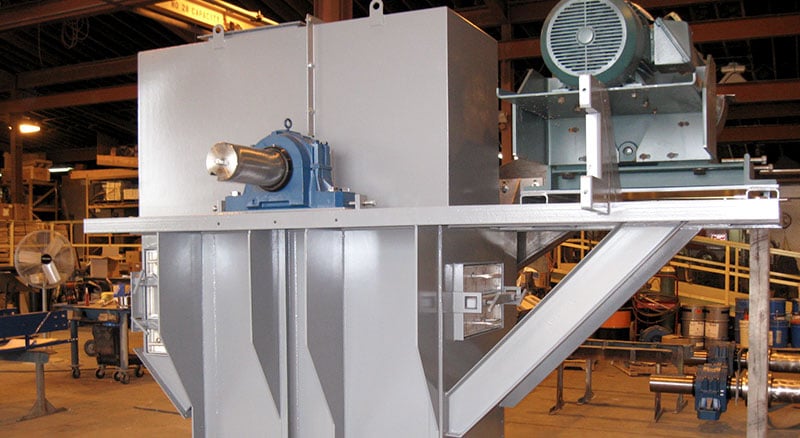
Bucket elevator head section in the FEECO fabrication facility
Additionally, choose a manufacturer that has enough experience to guide the elevator selection process, efficiently size the bucket elevator, and make recommendations based on the unique needs of the project at hand.
Learn more about choosing a bucket elevator manufacturer >>
Operational Growth
Facilities with the potential for operation growth should consider future capacity needs. As mentioned, elevators can accommodate a larger capacity in the future by designing for the greater needs and running at a reduced capacity in the interim to avoid having to replace the elevator more than once.
For smaller increases in capacity, adjusting elevator speed may also be an option.
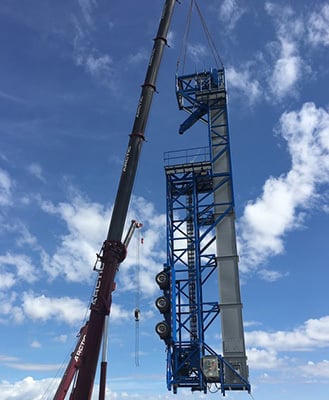
A new bucket elevator with service/access platform is prepared for installation
Preparing for the Replacement
Every bucket elevator installation is unique. Because of this, the process of replacing a bucket elevator can vary significantly from one job to the next. To minimize downtime, replacement is best coordinated with a planned outage. Further planning varies widely across each application, with considerations such as foundation requirements, removal of structural steel, additional equipment replacements, and more coming into play.
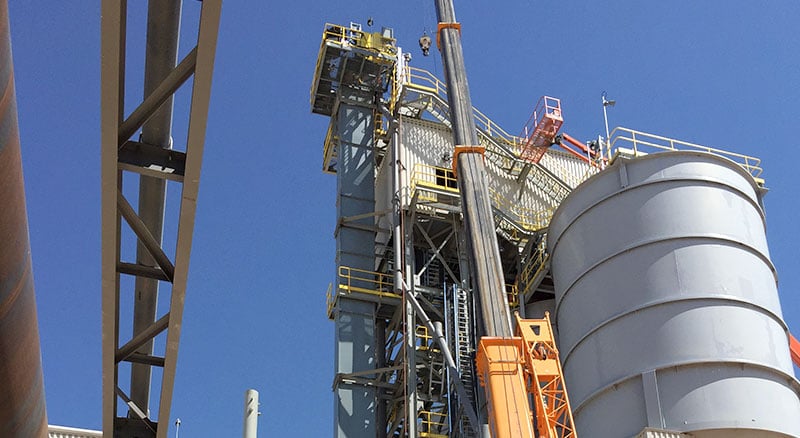
Bucket elevator installation in progress
Data Required
The chosen manufacturer will require a broad range of data. If only a duplicate unit is desired (with little-to-no required change), and the original manufacturer will be used, this process is fairly simple. In this case, the process may only require reviewing the original drawings to confirm the specifications are still a fit.
In other cases, the bucket elevator manufacturer will require a variety of different data points in order to properly size and spec a replacement elevator. Some of the key data points required include:
- Centrifugal or Continuous
- Belt or Chain
- Material Characteristics (angle of repose, bulk density, temperature, particle size distribution, etc.)
- Material Consistency (sticky, dry, oily, abrasive, etc.)
- Discharge Height
- Capacity
- Required Add-Ons (head service platform, walkways, ladders, etc.)
- Electrical Requirements
- Whether or not the unit must be chemical duty or explosion proof
The manufacturer will likely make a site visit to verify dimensions before the engineering begins, particularly when tight clearances are involved or the elevator will be passing through several floors of the building. Alternately, detailed drawings may suffice in some cases.
Conclusion
As a critical component in any production setting, replacing a worn out or inefficient bucket elevator requires careful attention to detail. While every installation is unique, considerations such as preventative replacement, improvement of the existing design, and manufacturer selection should all be taken into account.
FEECO is a leading provider of custom bucket elevators and complete bulk material handling systems. All FEECO handling equipment is engineered around the characteristics of the material to be handled and the unique process specifications to ensure an optimal handling solution. All equipment is manufactured to the highest quality standards for a long life of reliable performance. For more information on our bucket elevators, contact us today!

